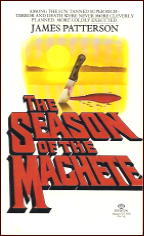Thu 18 Aug 2016
Archived Mystery Review: PATRICIA PONDER – Murder for Charity.
Posted by Steve under Authors , Reviews[5] Comments
PATRICIA PONDER – Murder for Charity. Manor 15281, paperback original, 1977.
Contradicting the ultra-macho image projected by the front cover, which shows the Cajun detective Louis Breaux being very protective of the cuddlesome Diana, this is in fact a detective story most reminiscent of the old-fashioned golden age of mystery fiction, complete with a country club overflowing with clues and suspects.
When Diana Parnell’s aunt is murdered while she’s running an antique show for charity, it’s Diana who’s suspected. The mysterious behavior of a friend caused her to be alone at the very moment for which an alibi is needed, but to her rescue comes Louis Breaux, convinced of her innocence even though they’ve only just met, and together they set off on the killer’s trail.
It must be remembered that most of the books of the golden age have been forgotten, with good reason. Only the Christie’s and the Queen’s still survive, and they’re the models that other writers of pure detective fiction must strive to equal. Here’s another that doesn’t measure up. When the clues are as falsely represented or slighted over as they are here, it may be playing fair with the reader in a technical sense, but the edges of an otherwise pleasing performance are curdled.
Nevertheless, flaws and all, it was a nice surprise to find this. Mildly recommended for those who are nostalgic for this sort of thing.
Rating: C.
[Note to bibliographers: Besides the haphazard proofreading system employed by Manor throughout the book, on the title page the author’s name is given as Patricia Maxwell.]
[UPDATE] Additional bibliographic notes: Patrica Ponder was indeed a pen name of Patricia Maxwell (1942- ). Under that name she also wrote Haven of Fear for Manor, 1977, but it is doubtful that Louis Breaux ever made another appearance.
Under her own name, Patricia Maxwell has seven entries in Al Hubin’s Crime Fiction IV, all apparently gothics or novels of romantic suspense. (The line between them is often blurry.) There is also one entry for her there as Elizabeth Trehearne, another gothic. She is best known to readers of romance fiction, however, as Jennifer Blake, with 50 or 60 titles in that genre, and still counting.
